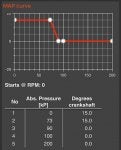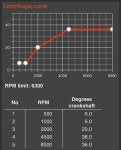There is alot of information about the 123ignition distributor scattered through a number of threads. I decided to sum up my experiences after 22 months and 15k miles of use.
This is the distributor that is sold by IAP for a little over $400. It is also available from some of the European Alfa parts places and it may be worthwhile checking them out if you plan to purchase. Keep an eye on the exchange rate and shipping costs.
I installed mine on my Spider in December 2007. It is a fairly hot motor with:
ported head (standard valves) by Richard Jemison
RJ136/785 cams - the same as or similar to the ones in Andy Besic's 200+ HP race motor
10:1 Motronic pistons
Weber 40DCOE116/117 carbs with 34mm venturis and Euro airbox
Shankle headers
The best part about the 123 is that the advance curves are accurate. I think that the claims for stronger sparks are questionable as it cannot be used with a low impedance, high energy coil.
The blurb lists 16 selectable curves but in reality there are "only" 8. Of these 8 distinct curves, 3 of them are for 1300 & 1600 motors and 5 are for 1750/2000 motors.
The Marelli 103B curve #F is very similar to the Bosch 0.231.178.006 and I doubt that anyone would be able to detect much difference between them, so there are 4 distinct 2L curves. I tried them all.
The Bosch 0.231.178.006 curve #A is a slow curve intended for low emisions. It enables a slow steady idle but produces mediocre throttle response and fuel consumption. It may be a good choice if you want to run on lower grade gasoline.
The Bosch 0.231.110.045 curve #1 is the standard Alfa curve for Euopean, carburetted cars. It is a good compromise curve. Decent throttle seponse, good idle and fuel consumption and slow enough to accomodate a lot of high rpm advance. I ran this curve with 40 degrees full advance with no pinging on 91 octane gas.
The Shankle 4255 curve #E has the best throttle response. The problem is with the idle. The curve is so steep in the 800-1500 range that the idle either climbs to about 1500 rpm or drops to 700. It is difficult to get it to idle at any rpm in between and I had to almost stall the engine to get it to settle at 700. It is a shame since the performance between 2000 and 3000 is outstanding.
The "006 tuning" curve #D is the Jim Karamalakis curve. It seems to be the best choice for my engine. The idle is easy to adjust since the curve is flat at 1000 rpm and the throttle response is good, if not as good as the Shankle.
The 123ignition website says that it is not compatible with electronic ignition boxes. This is clearly incorrect. I have mine hooked up to an MSD 6AL box. It fires a Milano, low impedance coil. I have the spark plug gaps opened up to 040". I expect that it is also compatible with Crane spark boxes.
I am very happy with this setup. My engine as considerable piston blowby and fairly high oil consumption. Plug fouling has been an issue for quite a while. The sparks from the 123/MSD combo are strong enough to prevent most of the hesitation that I had previously encountered. The engine revs easily to 7500 rpm and appears not to be limited by the ignition.
The distributor is well made but you need excellent eyesight or a magnifying glass and good light to see the curve selector switch.
IAP imply that you can set up the distributor using only the "P" mark. This is true if you have a variable delay timing light, but this is also true for any distributor. It is necessary to mark the pulley with the correct "F" mark for the curve of your choice if yopu are to use the static timing method. I always check the timing at maximum advance as I have found that the static timing methods usually produce errors.
I recommend the 123ignition distributor to anyone who wants to get away from the vagaries of centrifugal advance mechanisms. It is a big improvement on the Shankle/Marelliplex that I had before.
This is the distributor that is sold by IAP for a little over $400. It is also available from some of the European Alfa parts places and it may be worthwhile checking them out if you plan to purchase. Keep an eye on the exchange rate and shipping costs.
I installed mine on my Spider in December 2007. It is a fairly hot motor with:
ported head (standard valves) by Richard Jemison
RJ136/785 cams - the same as or similar to the ones in Andy Besic's 200+ HP race motor
10:1 Motronic pistons
Weber 40DCOE116/117 carbs with 34mm venturis and Euro airbox
Shankle headers
The best part about the 123 is that the advance curves are accurate. I think that the claims for stronger sparks are questionable as it cannot be used with a low impedance, high energy coil.
The blurb lists 16 selectable curves but in reality there are "only" 8. Of these 8 distinct curves, 3 of them are for 1300 & 1600 motors and 5 are for 1750/2000 motors.
The Marelli 103B curve #F is very similar to the Bosch 0.231.178.006 and I doubt that anyone would be able to detect much difference between them, so there are 4 distinct 2L curves. I tried them all.
The Bosch 0.231.178.006 curve #A is a slow curve intended for low emisions. It enables a slow steady idle but produces mediocre throttle response and fuel consumption. It may be a good choice if you want to run on lower grade gasoline.
The Bosch 0.231.110.045 curve #1 is the standard Alfa curve for Euopean, carburetted cars. It is a good compromise curve. Decent throttle seponse, good idle and fuel consumption and slow enough to accomodate a lot of high rpm advance. I ran this curve with 40 degrees full advance with no pinging on 91 octane gas.
The Shankle 4255 curve #E has the best throttle response. The problem is with the idle. The curve is so steep in the 800-1500 range that the idle either climbs to about 1500 rpm or drops to 700. It is difficult to get it to idle at any rpm in between and I had to almost stall the engine to get it to settle at 700. It is a shame since the performance between 2000 and 3000 is outstanding.
The "006 tuning" curve #D is the Jim Karamalakis curve. It seems to be the best choice for my engine. The idle is easy to adjust since the curve is flat at 1000 rpm and the throttle response is good, if not as good as the Shankle.
The 123ignition website says that it is not compatible with electronic ignition boxes. This is clearly incorrect. I have mine hooked up to an MSD 6AL box. It fires a Milano, low impedance coil. I have the spark plug gaps opened up to 040". I expect that it is also compatible with Crane spark boxes.
I am very happy with this setup. My engine as considerable piston blowby and fairly high oil consumption. Plug fouling has been an issue for quite a while. The sparks from the 123/MSD combo are strong enough to prevent most of the hesitation that I had previously encountered. The engine revs easily to 7500 rpm and appears not to be limited by the ignition.
The distributor is well made but you need excellent eyesight or a magnifying glass and good light to see the curve selector switch.
IAP imply that you can set up the distributor using only the "P" mark. This is true if you have a variable delay timing light, but this is also true for any distributor. It is necessary to mark the pulley with the correct "F" mark for the curve of your choice if yopu are to use the static timing method. I always check the timing at maximum advance as I have found that the static timing methods usually produce errors.
I recommend the 123ignition distributor to anyone who wants to get away from the vagaries of centrifugal advance mechanisms. It is a big improvement on the Shankle/Marelliplex that I had before.








